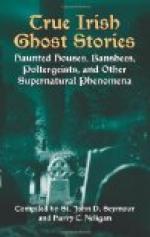A clergyman, who desires that all names be suppressed, sends the following: “In my wife’s father’s house a number of female servants were kept, of whom my wife, before she was married, was in charge. On one occasion the cook took ill with appendicitis, and was operated on in the Infirmary, where I attended her as hospital chaplain. She died, however, and was buried by her friends. Some days after the funeral my wife was standing at a table in the kitchen which was so placed that any person standing at it could see into the passage outside the kitchen, if the door happened to be open. [The narrator enclosed a rough plan which made the whole story perfectly clear.] She was standing one day by herself at the table, and the door was open. This was in broad daylight, about eleven o’clock in the morning in the end of February or beginning of March. She was icing a cake, and therefore was hardly thinking of ghosts. Suddenly she looked up from her work, and glanced through the open kitchen door into the passage leading past the servants’ parlour into the dairy. She saw quite distinctly the figure of the deceased cook pass towards the dairy; she was dressed in the ordinary costume she used to wear in the mornings, and seemed in every respect quite normal. My wife was not, at the moment, in the least shocked or surprised, but on the contrary she followed, and searched in the dairy, into which she was just in time to see her skirts disappearing. Needless to say, nothing was visible.”
Canon Courtenay Moore, M.A., Rector of Mitchelstown, contributes a personal experience. “It was about eighteen years ago—I cannot fix the exact date—that Samuel Penrose returned to this parish from the Argentine. He was getting on so well abroad that he would have remained there, but his wife fell ill, and for her sake he returned to Ireland. He was a carpenter by trade, and his former employer was glad to take him into his service again. Sam was a very respectable man of sincere religious feelings. Soon after his return he met with one or two rather severe accidents, and had a strong impression that a fatal one would happen him before long; and so it came to pass. A scaffolding gave way one day, and precipitated him on to a flagged stone floor. He did not die immediately, but his injuries proved fatal. He died in a Cork hospital soon after his admission: I went to Cork to officiate at his funeral. About noon the next day I was standing at my hall door, and the form of poor Sam, the upper half of it, seemed to pass before me. He looked peaceful and happy—it was a momentary vision, but perfectly distinct. The truncated appearance puzzled me very much, until some time after I read a large book by F.W.H. Myers, in which he made a scientific analysis and induction of such phenomena, and said that they were almost universally seen in this half-length form. I do not profess to explain what I saw: its message, if it had a message, seemed to be that poor Sam was at last at rest and in peace.”




